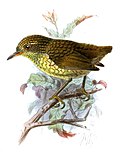Formicivora
| Formicivora | |
|---|---|

| |
| Southern white-fringed antwren (Formicivora grisea) | |
| Scientific classification | |
| Domain: | Eukaryota |
| Kingdom: | Animalia |
| Phylum: | Chordata |
| Class: | Aves |
| Order: | Passeriformes |
| Family: | Thamnophilidae |
| Genus: | Formicivora Swainson, 1824 |
| Type species | |
| Formicivora nigricollis[1] Swainson, 1825
| |
| Species | |
|
see text. | |
Formicivora is a genus of insectivorous birds in the antbird family, Thamnophilidae. These relatively small, long-tailed antbirds are strongly sexually dichromatic. They are found in semi-open habitats in woodland and shrub in South America. They have several rows of white spots on the wings. Males are usually darker below than they are above, and sometimes have a fringe of white on the side.
The genus Formicivora was introduced by the English naturalist William Swainson in 1824.[2][3] The type species is the southern white-fringed antwren.[4] The name of the genus Formicivora combines the Latin words formica for "ant" and -vorus "eating" from vorare "to devour".[5]
The Sincorá antwren was first described in 2007.[6] While initially placed in its own genus Stymphalornis, the marsh antwren belongs in Formicivora.[7] In contrast, the black-hooded antwren is not closely related to other Formicivora and may be better placed in its own genus.[7]
There are nine species:[8]
| Image | Common Name | Scientific Name | Distribution |
|---|---|---|---|
 |
Narrow-billed antwren | Formicivora iheringi | northern Atlantic Forest |
 |
Black-hooded antwren | Formicivora erythronotos | southern Atlantic Forest |
 |
Southern white-fringed antwren | Formicivora grisea | northern South America |
 |
Northern white-fringed antwren | Formicivora intermedia | Colombia and Venezuela |
 |
Serra antwren | Formicivora serrana | mid Atlantic Forest |
 |
Black-bellied antwren | Formicivora melanogaster | Brazil and eastern Bolivia |
 |
Rusty-backed antwren | Formicivora rufa | Brazil, eastern Bolivia and southern Amazonia |
 |
Sincorá antwren | Formicivora grantsaui | Serra do Espinhaço |
 |
Marsh antwren | Formicivora acutirostris | southern Atlantic Forest |
References
[edit]- ^ "Thamnophilidae". aviansystematics.org. The Trust for Avian Systematics. Retrieved 2023-07-16.
- ^ Swainson, William (1824). "An inquiry into the natural affinities of the Laniadae, or shrikes; preceded by some observations on the present state of ornithology in this country". Zoological Journal. 1: 289–307 [301].
- ^ Swainson, William (1825). "On two new genera of birds, Formicivora and Drymophila, with descriptions of several species". Zoological Journal. 2: 145–154 [145–149].
- ^ Peters, James Lee, ed. (1951). Check-list of Birds of the World. Vol. 7. Cambridge, Massachusetts: Museum of Comparative Zoology. p. 206.
- ^ Jobling, James A. (2010). The Helm Dictionary of Scientific Bird Names. London: Christopher Helm. p. 163. ISBN 978-1-4081-2501-4.
- ^ Gonzaga, L.P.; Carvalhaes, A.M.P.; Buzzetti, D.R.C. (2007). "A new species of Formicivora antwren from the Chapada Diamantina, eastern Brazil (Aves: Passeriformes: Thamnophilidae)" (PDF). Zootaxa. 1473: 25–38. doi:10.11646/zootaxa.1473.1.2. Archived from the original (PDF) on 2017-01-03. Retrieved 2018-03-07.
- ^ a b Buzzetti, D.R.C.; Belmonte-Lopes, R.; Reinert, B.L.; Silveira, L.F.; Bornschein, M.R. (2013). "A new species of Formicivora Swainson, 1824 (Thamnophilidae) from the state of São Paulo, Brazil". Revista Brasileira de Ornitologia. 21 (4): 269–291.
- ^ Gill, Frank; Donsker, David, eds. (2018). "Antbirds". World Bird List Version 8.1. International Ornithologists' Union. Retrieved 4 February 2018.

